Analysis of Comprehensive Land Consolidation in Cultivated Land Reserve Resource Areas Based on Two-Level Geographical Unit Division
Abstract
:1. Introduction
2. Materials and Methods
2.1. Study Area
2.2. Data Sources and Preprocessing
2.2.1. Data Sources
2.2.2. Data Preprocessing
2.3. Methods
2.3.1. Basic Unit Division
2.3.2. Evaluation of Basic Unit for CLC
2.3.3. Graph Theory Clustering Based on Kruskal Algorithm
- (1)
- Connected graph construction
- (2)
- Principle of Kruskal algorithm
- (3)
- Implementation of graph theory clustering
3. Results
3.1. Ecological Zone
3.1.1. Ecological Zone Distribution
3.1.2. Ecological Zone Type
3.1.3. Land Use Structure of Ecological Zones
3.2. Land Consolidation Units
3.2.1. Distribution of Land Consolidation Units
3.2.2. Land Consolidation Unit Type
3.2.3. Potential Analysis of Land Consolidation Unit
4. Discussion
- (1)
- Diversity of factors influencing CLC
- (2)
- Universality of the application of CLC analysis
- (3)
- RS image segmentation combined with graph theory clustering
- (4)
- Contributions and Limitations
5. Conclusions
Author Contributions
Funding
Data Availability Statement
Conflicts of Interest
References
- Li, J.; Pu, L.; Han, M.; Zhu, M.; Zhang, R.; Xiang, Y. Soil salinization research in China: Advances and prospects. J. Geogr. Sci. 2014, 24, 943–960. [Google Scholar] [CrossRef]
- Liu, Y.; Dai, L.; Long, H. Theories and practices of comprehensive land consolidation in promoting multifunctional land use. Habitat Int. 2023, 142, 102964. [Google Scholar] [CrossRef]
- Zhang, X.; Du, S.; Wang, Q. Hierarchical semantic cognition for urban functional zones with VHR satellite images and POI data. ISPRS-J. Photogramm. Remote Sens. 2017, 132, 170–184. [Google Scholar] [CrossRef]
- Zhou, W.; Ming, D.; Lv, X.; Zhou, K.; Bao, H.; Hong, Z. SO-CNN based urban functional zone fine division with VHR remote sensing image. Remote Sens. Environ. 2020, 236, 111458. [Google Scholar] [CrossRef]
- Dong, X.; Xu, Y.; Huang, L.; Liu, Z.; Xu, Y.; Zhang, K.; Hu, Z.; Wu, G. Exploring impact of spatial unit on urban land use mapping with multisource data. Remote Sens. 2020, 12, 3597. [Google Scholar] [CrossRef]
- Deng, Y.; He, R. Refined urban functional zone mapping by integrating open-source data. ISPRS Int. J. Geo-Inf. 2022, 11, 421. [Google Scholar] [CrossRef]
- Chang, S.; Wang, Z.; Mao, D.; Liu, F.; Lai, L.; Yu, H. Identifying urban functional areas in China’s Changchun City from Sentinel-2 Images and social sensing data. Remote Sens. 2021, 13, 4512. [Google Scholar] [CrossRef]
- Song, Y.; Wu, P. An interactive detector for spatial associations. Int. J. Geogr. Inf. Sci. 2021, 35, 1676–1701. [Google Scholar] [CrossRef]
- Chen, Y.; Liu, X.; Li, X.; Liu, X.; Yao, Y.; Hu, G.; Xu, X.; Pei, F. Delineating urban functional areas with building-level social media data: A dynamic time warping (DTW) distance based k-medoids method. Landsc. Urban Plan. 2017, 160, 48–60. [Google Scholar] [CrossRef]
- Walsh, A.; Costola, D.; Labaki, L.C. Performance-based climatic zoning method for building energy efficiency applications using cluster analysis. Energy 2022, 255, 124477. [Google Scholar] [CrossRef]
- Deng, X.; Tan, Z.; Tan, M.; Chen, W. A clustering-based climatic zoning method for office buildings in China. J. Build. Eng. 2021, 42, 102778. [Google Scholar] [CrossRef]
- Gavioli, A.; de Souza, E.G.; Bazzi, C.L.; Schenatto, K.; Betzek, N.M. Identification of management zones in precision agriculture: An evaluation of alternative cluster analysis methods. Biosyst. Eng. 2019, 181, 86–102. [Google Scholar] [CrossRef]
- Behera, S.K.; Mathur, R.K.; Shukla, A.K.; Suresh, K.; Prakash, C. Spatial variability of soil properties and delineation of soil management zones of oil palm plantations grown in a hot and humid tropical region of southern India. Catena 2018, 165, 251–259. [Google Scholar] [CrossRef]
- Hu, X.; Han, Y.; Yu, B.; Geng, Z.; Fan, J. Novel leakage detection and water loss management of urban water supply network using multiscale neural networks. J. Clean Prod. 2021, 278, 123611. [Google Scholar] [CrossRef]
- Scitovski, S. A density-based clustering algorithm for earthquake zoning. Comput. Geosci. 2018, 110, 90–95. [Google Scholar] [CrossRef]
- Zahn, C.T. Graph-theoretical methods for detecting and describing gestalt clusters. IEEE Trans. Comput. 1971, 100, 68–86. [Google Scholar] [CrossRef]
- Kim, S.; Choi, T.; Kim, S.; Kwon, T.; Lee, T.H.; Lee, K. Sequential graph-based routing algorithm for electrical harnesses, tubes, and hoses in a commercial vehicle. J. Intell. Manuf. 2021, 32, 917–933. [Google Scholar] [CrossRef]
- Muni, M.K.; Parhi, D.R.; Kumar, P.B.; Kumar, S. Motion control of multiple humanoids using a hybridized prim’s algorithm-fuzzy controller. Soft Comput. 2021, 25, 1159–1180. [Google Scholar] [CrossRef]
- Loria, A.; Dasdemir, J.; Jarquin, N.A. Leader-follower formation and tracking control of mobile robots along straight paths. IEEE Trans. Control Syst. Technol. 2016, 24, 727–732. [Google Scholar] [CrossRef]
- Zhu, S.; Liu, Y.; Lou, Y.; Cao, J. Stabilization of logical control networks: An event-triggered control approach. Sci. China-Inf. Sci. 2020, 63, 1122031. [Google Scholar] [CrossRef]
- Dimitriadis, S.I.; Salis, C.; Tarnanas, I.; Linden, D.E. Topological filtering of dynamic functional brain networks unfolds informative chronnectomics: A novel data-driven thresholding scheme based on orthogonal minimal spanning trees (OMSTs). Front. Neuroinformatics 2017, 11, 28. [Google Scholar] [CrossRef]
- Zhang, X.; Chen, G.; Wang, W.; Wang, Q.; Dai, F. Object-based land-cover supervised classification for very-high-resolution UAV images using stacked denoising autoencoders. IEEE J. Sel. Top. Appl. Earth Observ. Remote Sens. 2017, 10, 3373–3385. [Google Scholar] [CrossRef]
- Jiang, G.; Zhang, R.; Ma, W.; Zhou, D.; Wang, X.; He, X. Cultivated land productivity potential improvement in land consolidation schemes in Shenyang, China: Assessment and policy implications. Land Use Policy 2017, 68, 80–88. [Google Scholar] [CrossRef]
- Pasakarnis, G.; Maliene, V.; Dixon-Gough, R.; Malys, N. Decision support framework to rank and prioritise the potential land areas for comprehensive land consolidation. Land Use Policy 2021, 100, 104908. [Google Scholar] [CrossRef]
- Zhou, J.; Qin, X.; Liu, L.; Hu, Y. A potential evaluation model for land consolidation in fragmental regions. Ecol. Indic. 2017, 74, 230–240. [Google Scholar] [CrossRef]
- Kruskal, J.B. On the shortest spanning subtree of a graph and the traveling salesman problem. Proc. Am. Math. Soc. 1956, 7, 48–50. [Google Scholar] [CrossRef]
- Prim, R.C. Shortest connection networks and some generalizations. Bell Syst. Tech. J. 1957, 36, 1389–1401. [Google Scholar] [CrossRef]
- Zhuang, D.; Liu, J. Study on the model of regional differentiation of land use degree in China. J. Nat. Resour. 1997, 12, 105–111. [Google Scholar]
- Robert, C.; Ralph, D.; Rudolf, D.G.; Stephen, F.; Monica, G.; Bruce, H.; Karin, L.; Shahid, N.; Robert, V.O.; Jose, P.; et al. The value of the world’s ecosystem services and natural capital. Nature 1997, 387, 6630. [Google Scholar]
- Rao, J. Comprehensive land consolidation as a development policy for rural vitalisation: Rural in situ urbanisation through semi socio-economic restructuring in Huai Town. J. Rural Stud. 2022, 93, 386–397. [Google Scholar] [CrossRef]
- Zhou, J.; Li, C.; Chu, X.; Luo, C. Is Cultivated Land Increased by Land Consolidation Sustainably Used in Mountainous Areas? Land 2022, 11, 2236. [Google Scholar] [CrossRef]
- Asiama, K.O.; Bennettb, R.M.; Zevenbergena, J.A.; Mano, A.D.S. Responsible consolidation of customary lands: A framework for land reallocation. Land Use Policy 2019, 83, 412–423. [Google Scholar] [CrossRef]
- Luo, L.; Yang, C.; Chen, R.; Liu, W. Comprehensive Land Consolidation Zoning Based on Minimum Cumulative Resistance Model—A Case Study of Chongqing, Southwest China. Land 2023, 12, 1935. [Google Scholar] [CrossRef]
- Feng, W.; Li, Y. Measuring the Ecological Safety Effects of Land Use Transitions Promoted by Land Consolidation Projects: The Case of Yan’an City on the Loess Plateau of China. Land 2021, 10, 783. [Google Scholar] [CrossRef]
- Zang, Y.; Yang, Y.; Liu, Y. Toward serving land consolidation on the table of sustainability: An overview of the research landscape and future directions. Land Use Policy 2021, 109, 105696. [Google Scholar] [CrossRef]
- Mo, W.; Zhao, Y.; Yang, N.; Xu, Z. Ecological function zoning based on ecosystem service bundles and trade-offs: A study of Dongjiang Lake Basin, China. Environ. Sci. Pollut. Res. 2023, 30, 40388–40404. [Google Scholar] [CrossRef] [PubMed]
- Xiao, P.; Zhao, C.; Zhou, Y.; Feng, H.; Li, X.; Jiang, J. Study on land consolidation zoning in Hubei Province based on the coupling of neural network and cluster analysis. Land 2021, 10, 756. [Google Scholar] [CrossRef]
- Lv, T.; Zeng, C.; Lin, C.; Liu, W.; Cheng, Y.; Li, Y. Towards an integrated approach for land spatial ecological restoration zoning based on ecosystem health assessment. Ecol. Indic. 2023, 147, 110016. [Google Scholar] [CrossRef]
- Faraslis, I.; Dalezios, N.R.; Alpanakis, N.; Tziatzios, G.A.; Spiliotopoulos, M.; Sakellariou, S.; Sidiropoulos, P.; Dercas, N.; Dominguez, A.; Martinez-Lopez, J.A.; et al. Remotely sensed agroclimatic classification and zoning in water-limited Mediterranean areas towards sustainable agriculture. Remote Sens. 2023, 15, 5720. [Google Scholar] [CrossRef]
- Xu, C.; Yang, G.; Wan, R.; Ou, W.; Wang, P. Toward ecological function zoning and comparison to the Ecological Redline Policy: A case study in the Poyang Lake Region, China. Environ. Sci. Pollut. Res. 2021, 28, 40178–40191. [Google Scholar] [CrossRef]
- Xu, K.; Wang, J.; Wang, J.; Wang, X.; Chi, Y.; Zhang, X. Environmental function zoning for spatially differentiated environmental policies in China. J. Environ. Manag. 2020, 255, 109485. [Google Scholar] [CrossRef] [PubMed]
- Zeng, J.; Cui, X.; Chen, W.; Yao, X. Ecological management zoning based on the supply-demand relationship of ecosystem services in China. Appl. Geogr. 2023, 155, 102959. [Google Scholar] [CrossRef]
- Zhao, H.; He, J.; Liu, D.; Han, Y.; Zhou, Z.; Niu, J. Incorporating ecological connectivity into ecological functional zoning: A case study in the middle reaches of Yangtze River urban agglomeration. Ecol. Inform. 2023, 75, 102098. [Google Scholar] [CrossRef]

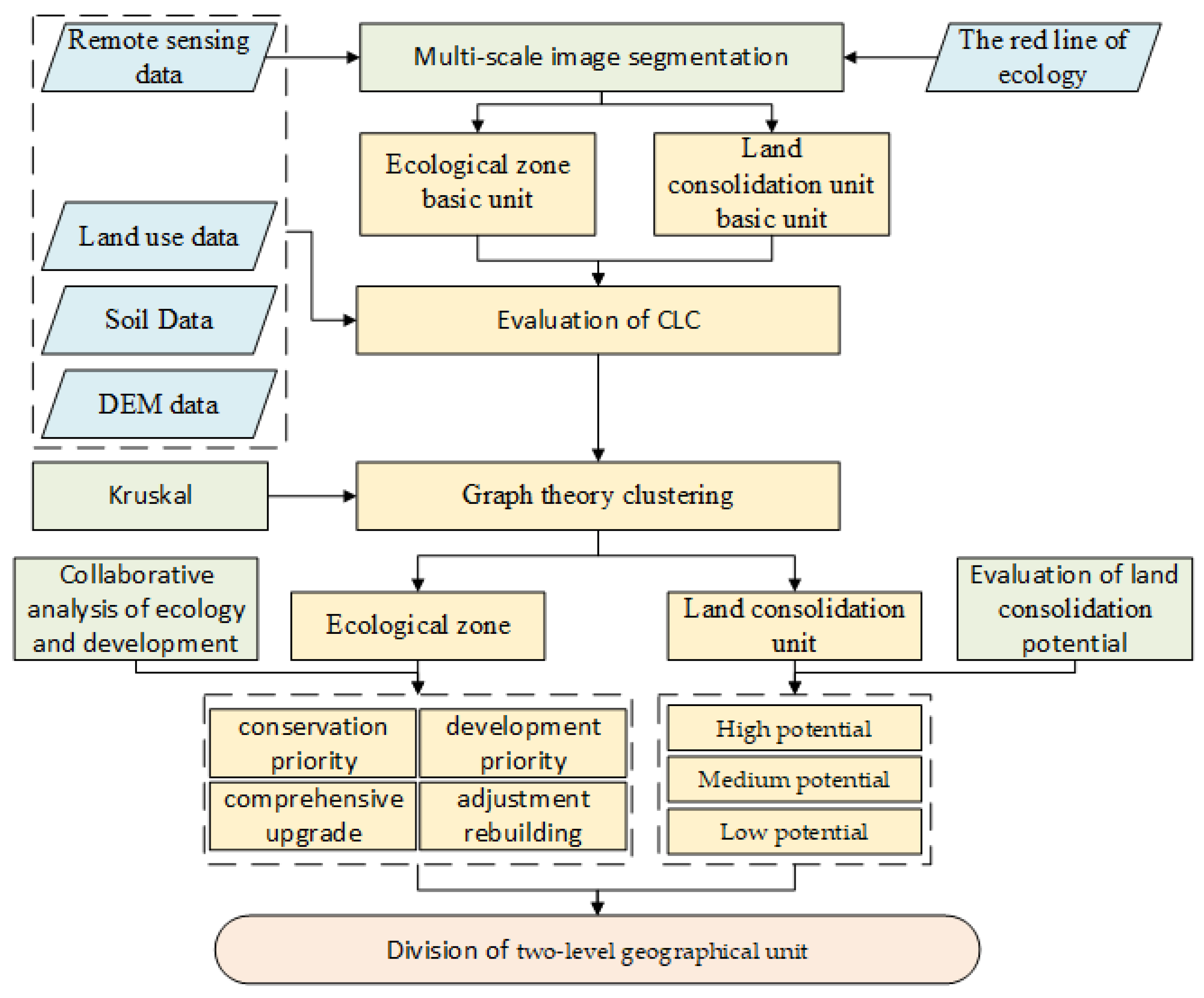


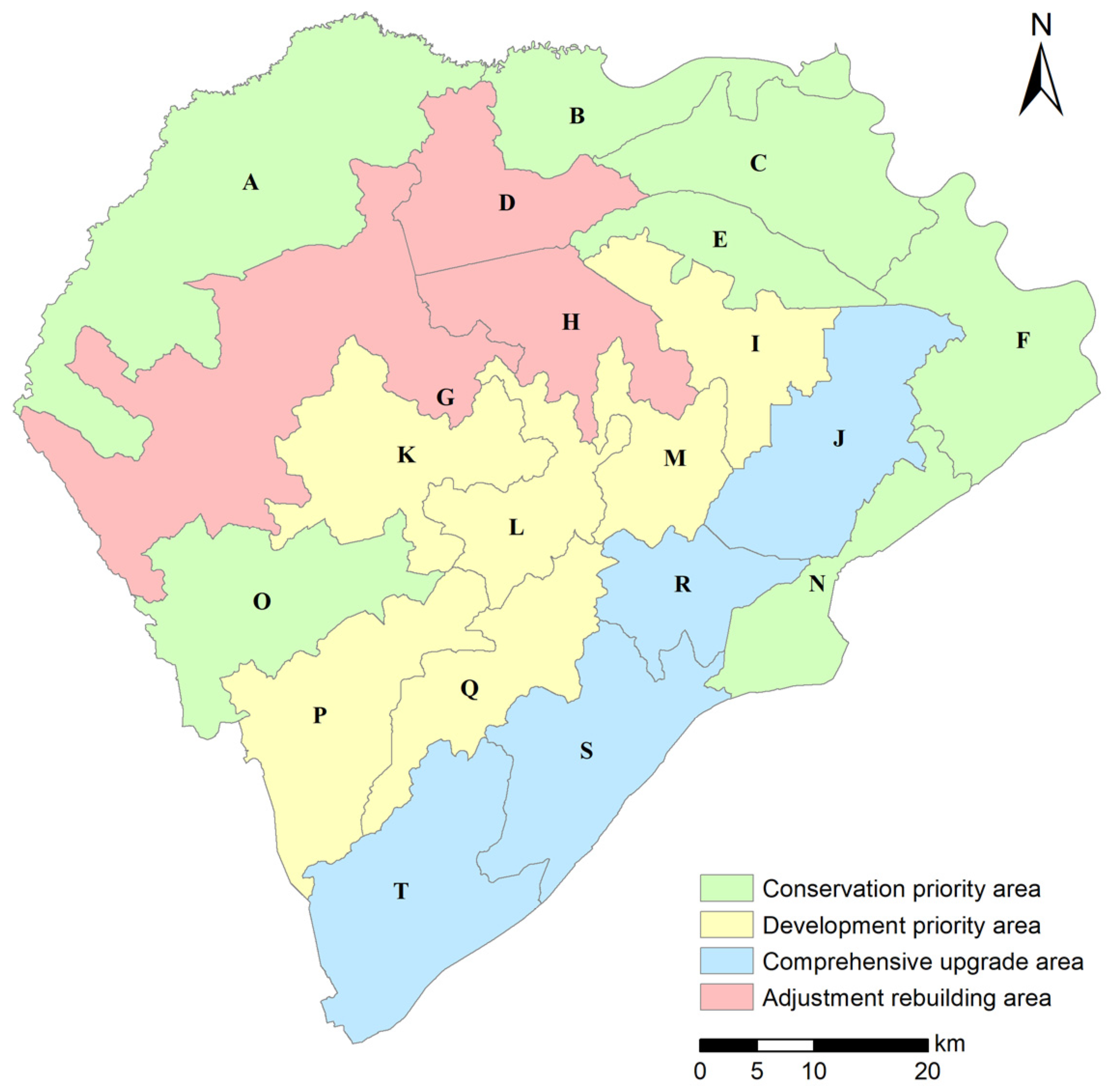

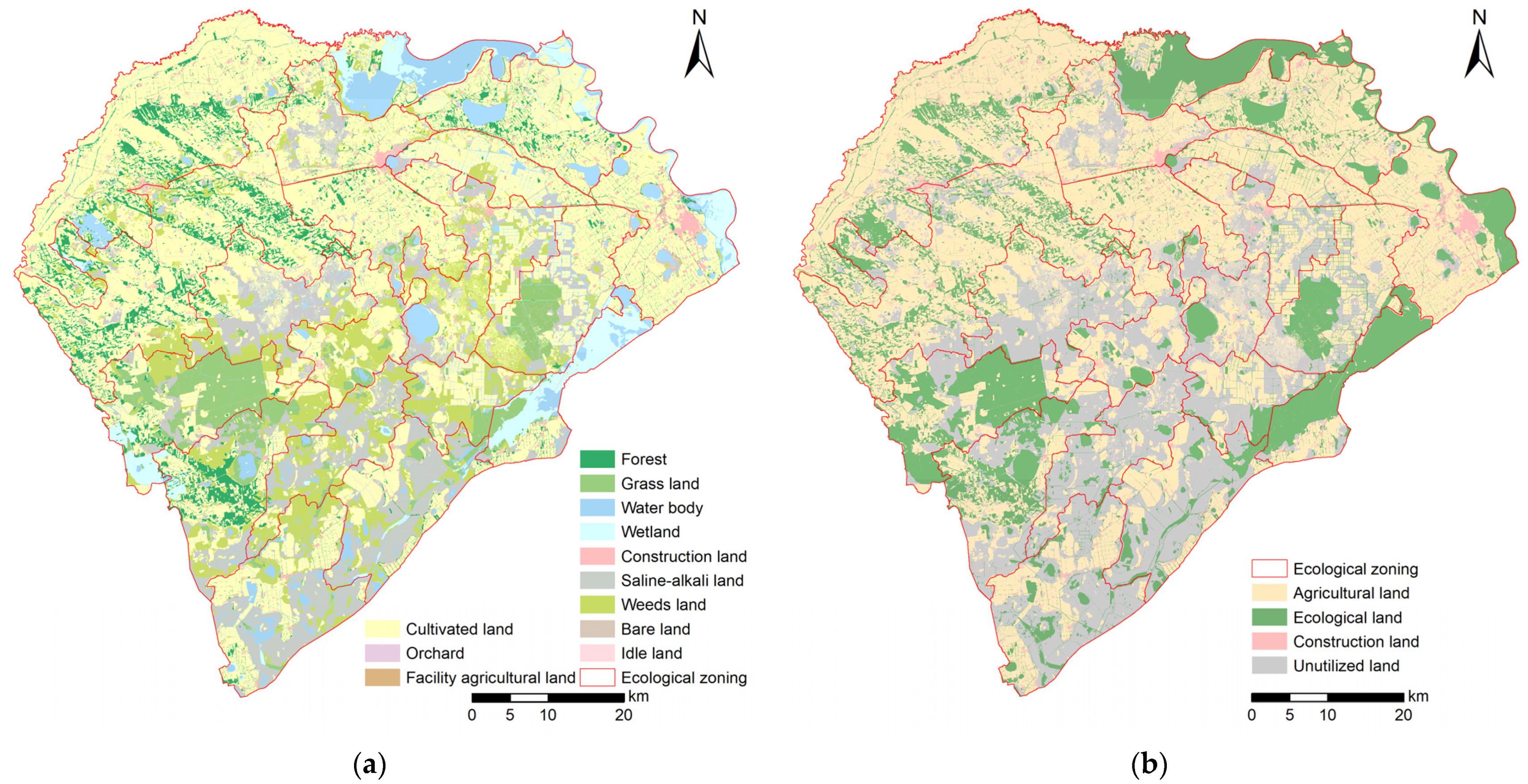

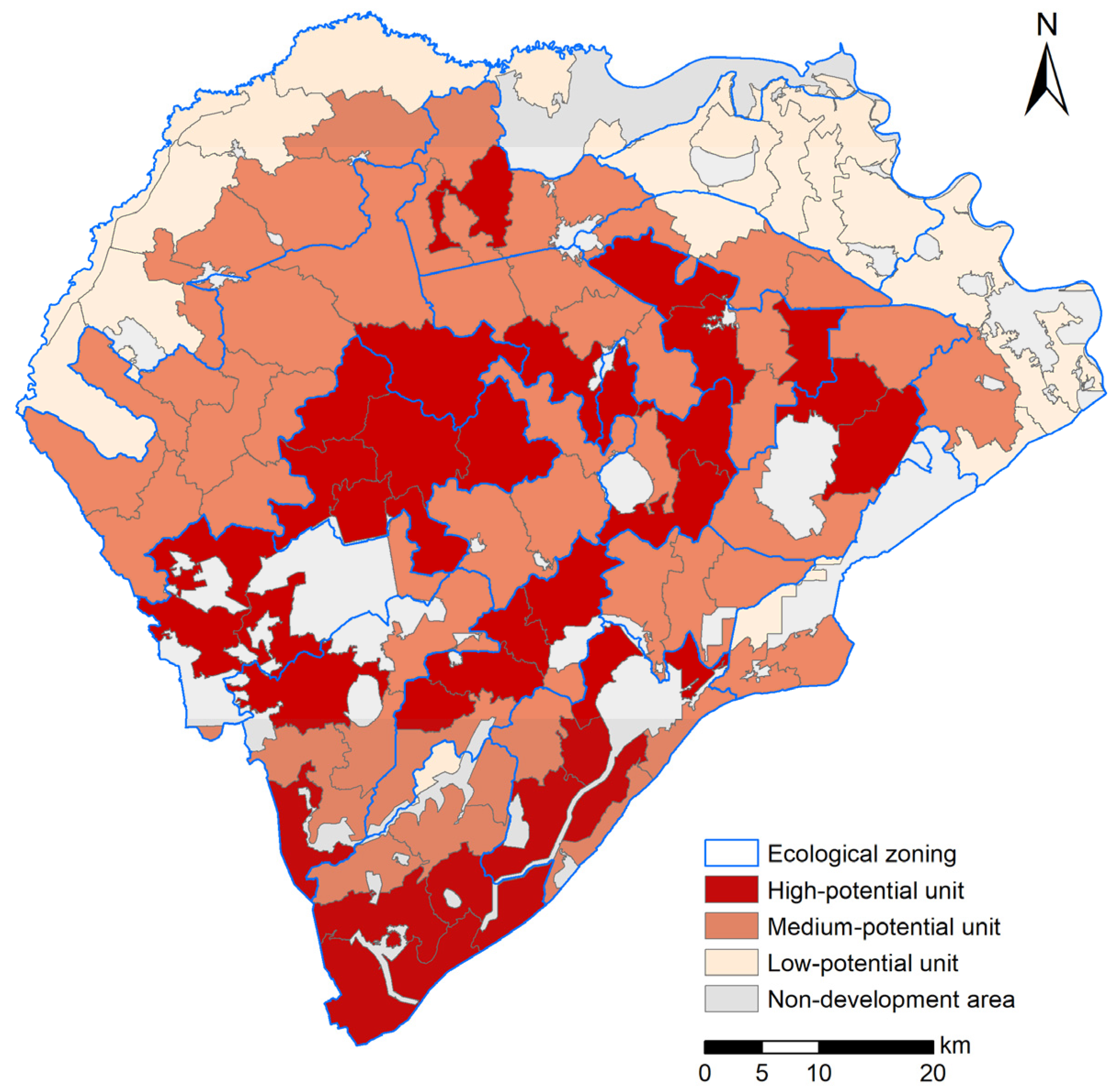
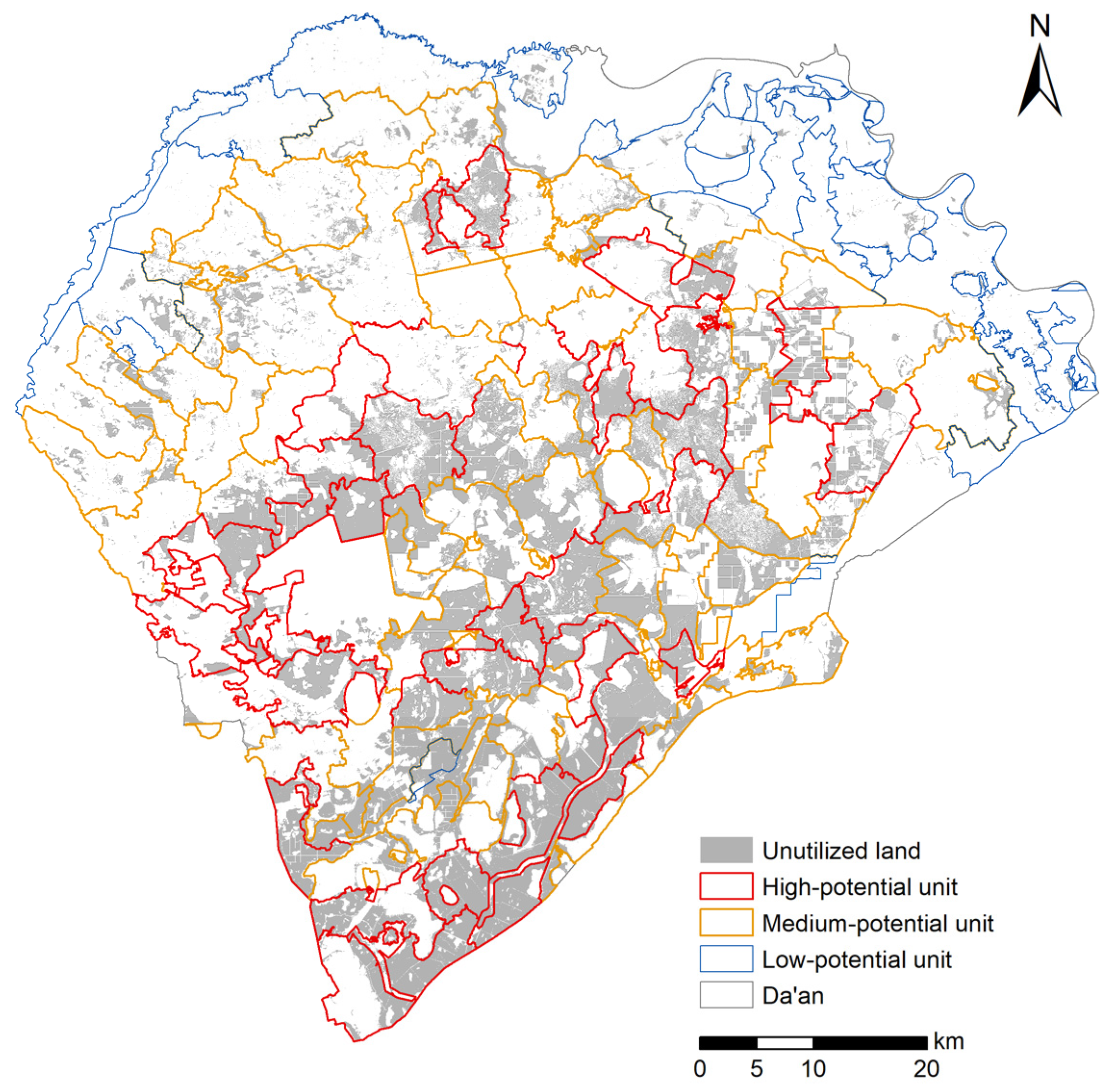

| Land Use Category | Land Use |
|---|---|
| Agricultural land | Cultivated land, orchard, facility agricultural land |
| Ecological land | Forest, grass land, water body, wetland |
| Construction land | Urban construction land, transportation land, Industrial mining and storage land |
| Unutilized land | Saline–alkali land, weed land, bare land, idle land |
| Level | Dimension | Index | Formula | Relativity | Weight |
|---|---|---|---|---|---|
| Ecological zone | Development | Land use degree 1 | − | 0.33 | |
| Saline–alkali land connectivity | Saline–alkali land area/ number of saline–alkali land areas | + | 0.67 | ||
| Ecology | Vegetation coverage | (NDVI − NDVImin)/ (NDVImax − NDVImin) | + | 0.28 | |
| Ecological service value 2 | + | 0.72 | |||
| Land consolidation unit | Land potential | Proportion of saline–alkali land | Saline–alkali land area/area×100% | + | 0.49 |
| Soil salinity degree | − | 0.17 | |||
| Distance from water source | + | 0.22 | |||
| Slope | − | 0.12 |
| Ecological Zone | Conservation Priority Area | Adjustment Rebuilding Area | Development Priority Area | Comprehensive Upgrade Area | Total Area | Type |
|---|---|---|---|---|---|---|
| A | 287.55 | 232.22 | 46.26 | 9.80 | 575.82 | Conservation priority area |
| B | 178.88 | 0.00 | 0.00 | 0.00 | 178.88 | Conservation priority area |
| C | 148.38 | 34.91 | 0.00 | 83.59 | 266.88 | Conservation priority area |
| D | 0.00 | 94.01 | 79.06 | 12.18 | 185.25 | Adjustment rebuilding area |
| E | 77.79 | 4.41 | 0.00 | 45.25 | 127.44 | Conservation priority area |
| F | 121.08 | 116.13 | 0.00 | 31.03 | 268.24 | Conservation priority area |
| G | 50.73 | 425.16 | 52.98 | 32.37 | 561.25 | Adjustment rebuilding area |
| H | 0.00 | 162.78 | 22.13 | 8.46 | 193.37 | Adjustment rebuilding area |
| I | 42.43 | 12.92 | 86.12 | 33.08 | 174.55 | Development priority area |
| J | 31.54 | 3.63 | 36.14 | 182.26 | 253.57 | Comprehensive upgrade area |
| K | 0.00 | 0.00 | 236.15 | 10.99 | 247.15 | Development priority area |
| L | 26.02 | 54.00 | 65.52 | 10.92 | 156.46 | Development priority area |
| M | 0.00 | 5.20 | 100.99 | 27.99 | 134.18 | Development priority area |
| N | 72.60 | 6.77 | 11.79 | 57.83 | 148.99 | Conservation priority area |
| O | 104.08 | 12.33 | 54.80 | 86.56 | 257.76 | Conservation priority area |
| P | 59.14 | 17.57 | 109.76 | 88.61 | 275.08 | Development priority area |
| Q | 0.00 | 0.00 | 107.84 | 82.22 | 190.06 | Development priority area |
| R | 10.59 | 14.24 | 33.11 | 74.04 | 131.98 | Comprehensive upgrade area |
| S | 15.08 | 7.73 | 105.36 | 122.34 | 250.51 | Comprehensive upgrade area |
| T | 29.40 | 19.39 | 107.16 | 145.65 | 301.60 | Comprehensive upgrade area |
| Land Use Type | Conservation Priority Area | Development Priority Area | Comprehensive Upgrade Area | Adjustment Rebuilding Area | ||||
|---|---|---|---|---|---|---|---|---|
| Area/km2 | Proportion | Area/km2 | Proportion | Area/km2 | Proportion | Area/km2 | Proportion | |
| Cultivated land | 945.84 | 51.85% | 397.08 | 33.72% | 322.66 | 34.41% | 601.47 | 63.99% |
| Orchard | 1.28 | 0.07% | 0.03 | 0.00% | 0.06 | 0.01% | 0.13 | 0.01% |
| Facility agricultural land | 2.20 | 0.12% | 0.62 | 0.05% | 0.86 | 0.09% | 1.59 | 0.17% |
| Forest | 154.35 | 8.46% | 61.91 | 5.26% | 16.92 | 1.80% | 134.05 | 14.26% |
| Grass land | 117.00 | 6.41% | 57.39 | 4.87% | 78.20 | 8.34% | 5.24 | 0.56% |
| Water body | 214.87 | 11.78% | 63.08 | 5.36% | 74.59 | 7.95% | 12.35 | 1.31% |
| Wetland | 172.09 | 9.43% | 8.76 | 0.74% | 10.16 | 1.08% | 2.86 | 0.30% |
| Construction land | 82.27 | 4.51% | 28.27 | 2.40% | 25.35 | 2.70% | 45.71 | 4.86% |
| Saline–alkali land | 50.07 | 2.75% | 285.22 | 24.22% | 241.78 | 25.79% | 63.23 | 6.73% |
| Weed land | 83.10 | 4.56% | 273.40 | 23.22% | 166.08 | 17.71% | 72.72 | 7.74% |
| Bare land | 0.94 | 0.05% | 1.71 | 0.15% | 1.00 | 0.11% | 0.49 | 0.05% |
| Idle land | 0.01 | 0.00% | 0.00 | 0.00% | 0.00 | 0.00% | 0.03 | 0.00% |
| Type of Units | Number of Units | Area/km2 | Proportion |
|---|---|---|---|
| High-potential unit | 37 | 1280.68 | 26.25% |
| Medium-potential unit | 53 | 2002.13 | 41.04% |
| Low-potential unit | 26 | 845.62 | 17.33% |
| Non-development area | - | 750.60 | 15.38% |
| Total | 116 | 4879.03 | 100% |
| Types of Units | Area/km2 | Proportion |
|---|---|---|
| High-potential unit | 659.01 | 51.46% |
| Medium-potential unit | 441.48 | 22.05% |
| Low-potential unit | 39.48 | 4.67% |
Disclaimer/Publisher’s Note: The statements, opinions and data contained in all publications are solely those of the individual author(s) and contributor(s) and not of MDPI and/or the editor(s). MDPI and/or the editor(s) disclaim responsibility for any injury to people or property resulting from any ideas, methods, instructions or products referred to in the content. |
© 2024 by the authors. Licensee MDPI, Basel, Switzerland. This article is an open access article distributed under the terms and conditions of the Creative Commons Attribution (CC BY) license (https://creativecommons.org/licenses/by/4.0/).
Share and Cite
Li, S.; Zhang, C.; Luo, C.; Li, S.; Yun, W.; Gao, B. Analysis of Comprehensive Land Consolidation in Cultivated Land Reserve Resource Areas Based on Two-Level Geographical Unit Division. Land 2024, 13, 470. https://doi.org/10.3390/land13040470
Li S, Zhang C, Luo C, Li S, Yun W, Gao B. Analysis of Comprehensive Land Consolidation in Cultivated Land Reserve Resource Areas Based on Two-Level Geographical Unit Division. Land. 2024; 13(4):470. https://doi.org/10.3390/land13040470
Chicago/Turabian StyleLi, Shaner, Chao Zhang, Chenying Luo, Shaoshuai Li, Wenju Yun, and Bingbo Gao. 2024. "Analysis of Comprehensive Land Consolidation in Cultivated Land Reserve Resource Areas Based on Two-Level Geographical Unit Division" Land 13, no. 4: 470. https://doi.org/10.3390/land13040470





